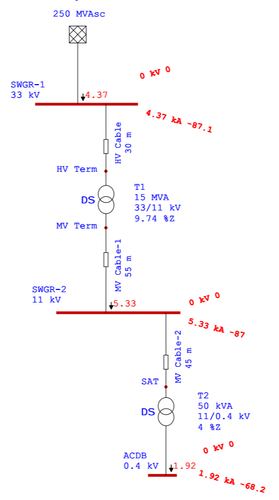Power system studies are essential tools in understanding the expected performance of an electrical system and determining the severity of a fault or other unexpected event.

There are many different types of power system studies, each with their own special purpose and calculation method. Each analysis is unique to a particular power system, any changes within the system can affect the results of the analysis and require recalculation.
Following are the most common power system studies
Load Flow Studies :
A load flow study determines the active and reactive power, voltage, current, and power factor throughout an electrical system.
Data used for modeling of the system will be tabulated in the report along with tabulations of current, active, and reactive power, voltage, and equipment ratings.
Short Circuit Studies :
Short circuit analysis is used to determine the ability of each component within the electrical system to withstand and/or interrupt the system current. Short circuit studies provide an analysis of all possible operating scenarios which will be or have been influenced by, the proposed or completed additions or changes to the subject system.
Tabulation of equipment short-circuits current ratings versus available fault duties can be found in this study. The study report should identify the percentage of rated short circuit current and clearly note which equipment has insufficient ratings.
Load flow and short circuit study as basic operational requirements to validate ratings of the electrical study. Results obtained from these studies are used as base input for Relay Coordination, Arc flash & transient studies.
Transient Stability Studies : 
A transient stability study determines the ability of the synchronous machines within an electrical system to remain in step with one another following a disturbance. Stability studies provide an analysis of disturbances for all possible operating scenarios.
Descriptions of the scenarios evaluated and tabulations or graphs showing the calculation results are also included with conclusions and recommendations by the engineer performing the study.
Coordination study:
The coordination study determines the extent of overcurrent protective device coordination within an electrical system and provides an analysis of all possible operating scenarios. Determine protective device characteristics, settings, or sizes that provide a balance between equipment protection and selective device operation that is optimum for the electrical system. Information contained within a coordination study includes a system one-line diagram along with Time-current curves, selective coordination ratios of fuses, or selective coordination tables of circuit breakers demonstrating the coordination of overcurrent protective devices to the scope.
It also includes the tabulation of protective devices identifying circuit location, Manufacturer, Instrument transformer ratio, IEEE device number, recommended settings, and TCC curves.
Arc Flash Studies :
The purpose of the arc-flash analysis is to determine the arc-flash incident energy levels and flash-protection boundary distances of electrical equipment based on results found in short-circuit and coordination studies. The analysis is performed under worst-case arc-flash conditions for all modes of operation and provides an analysis of all possible operating scenarios.
Short circuit and coordination studies are performed to determine the available energy of an electrical system and the expected clearing time of protective devices, the arc-flash hazard analysis selects the working distances and calculates the incident energy at each fault location at the prescribed working distance. Based on this information, the arc-flash hazard PPE category for the calculated incident energy level can be specified along with the flash protection boundary at each fault location.
Arc flash data is used to generate labels that are applied to system components, informing workers of the available incident energy at a particular piece of equipment and the appropriate levels of Personal Protective Equipment that should be worn while performing work.

